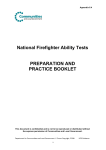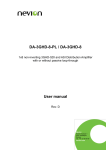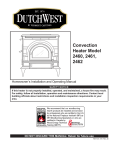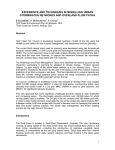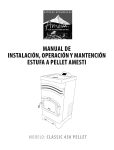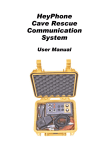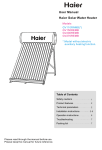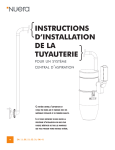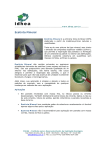Download Practice questions for the Working with Numbers Test
Transcript
On-Call Firefighter Written Tests Practice Booklet Section One: Introduction About this booklet This booklet has been developed to help you prepare for the On-Call Firefighter Ability Tests which form part of our selection process for On-Call Firefighters. This booklet is divided into nine sections: Section One: Introduction - this section introduces the tests and provides you with a brief description of what they are. Section Two: Preparing for the Tests - this section provides you with some general advice on preparing to take the tests. Section Three: Working with Numbers & Understanding Information Question Booklets and Answer Sheets - the Working with Numbers and Understanding Information Tests use multiple choice responses; this section gives guidance on how to use the question booklets and answer sheets. Section Four: Practice Questions for the Working with Numbers Test - this section contains the instructions and some practice questions to help familiarise you with what to expect when you take the Working with Numbers Test. Section Five: Practice Questions for the Understanding Information Test - this section contains the instructions and some practice questions to help familiarise you with what to expect when you take the Understanding Information Test. Section Six: Answers to the Practice Questions – this section contains the correct answers for the practice questions for Working with Number and Understanding Information so that you can check your own answers. Section Seven: Dictation Test – this section contains information about what to expect when you take the Dictation Test. Section Eight: Memory Retention, Recall and Written Test – this section contains information about what to expect when you take the Memory Retention, Recall and Written Test. Section Nine: Frequently Asked Questions - this section includes answers to some questions you may have about the tests and testing sessions. We strongly recommend you set aside some time to read through this booklet and practice questions prior to your assessment day. On-Call Firefighter Ability Tests There are four tests that make up these Ability Tests, these are the: Working with Numbers Test. This is a timed test that lasts 45 minutes. Firefighters need to be able to make basic mathematical calculations, e.g. for interpreting gauges or calculating how much hose is needed at a fire. This test will examine these abilities. Understanding Information Test. This is a timed test that lasts 30 minutes. It assesses your ability to understand and interpret the type of written information that you may commonly come across as a Firefighter. Dictation Test. This test is designed to assess your ability to listen and write down information and to ensure you can communicate information in writing; your handwriting must be legible. In addition you will be assessed on your spelling, grammar and use of punctuation. Memory Retention, Recall and Written Test. This test assesses your ability to work under pressure, to understand and recall relevant information and to ensure that you can communicate information in writing. The tests have been designed to be highly relevant to the work of Firefighters. They use scenarios and questions that reflect the type of activities and decisions that Firefighters may need to make on a routine basis. Whilst realistic and relevant to the Firefighter role no specific knowledge or experience of being a Firefighter is required to complete the tests. You will not be at a disadvantage if you do not have this knowledge or experience. The tests are being used as they provide objective, fair and relevant information on the key Personal Qualities and Attributes (PQAs) needed to become a successful Firefighter. Each test is assessed separately, but will be looked at together to form an overall measure of your suitability to become a Firefighter. The tests are paper based and you will be given full instructions on how to complete each one before you take each test. An Administrator will also be present at the testing session and will guide you on each stage of the process. At the beginning of the assessments there will be example questions to check that you have understood the instructions and to make sure you feel comfortable taking the test. Section Two: Preparing for the tests There are a number of things you can do to help you prepare to take the Ability Tests. We suggest you set aside some time to undertake the preparation described below. General Preparation Ensure that you are comfortable with the administrative arrangements that have been made for you, if you are not, raise any concerns with the Human Resources Section. In particular, check that you know: the date, time and location of the testing session (these will be detailed on your invitation); and the time it will take you to get to the venue and the travel arrangements you need to make. If you have any special requirements, please ensure that you have informed the Human Resources Section in plenty of time prior to the event, so that the necessary arrangements can be made. Complete the Practice Questions In Sections 4-5 of this booklet there are practice questions for the Working with Numbers & Understanding Information Tests. These are examples of the sort of questions that you will be asked. Whilst they are not the actual questions that you will be presented with, they will nevertheless give you a realistic preview of what you will encounter during the actual assessment. You should complete these as part of your preparation. Remember: These questions are for practice only – they are not the questions you will be asked during the real assessment. Have a go at each of the practice questions – this will help you become familiar with the process and format of the questions. You may try them as often as you like. Your „results‟ will not be collected or used by anyone – they are for your information only. The Day Before Try not to dwell on the assessments or become anxious about them – stay relaxed and keep yourself occupied. Get plenty of rest and get a good night‟s sleep. On The Day Allow plenty of time to get to the test venue – try to arrive at least 30 minutes early, as you will not be allowed to enter the test room if you arrive once testing has started. You do not need to bring paper, pencils, calculators or any other equipment as everything you need will be provided for you. Please note, you will not be permitted to use calculators for the purpose of the Working with Numbers test. Wear comfortable clothing. Do not drink alcohol or take any strong medication prior to the assessment session. Make sure that you are physically comfortable before the test session starts (visit the toilet, have a drink of water, make sure that you have eaten something etc.) During the Test Session The session will run for about 2 ½ hours in total. Ensure that you can see and hear the Administrator comfortably and if not, tell him / her. Inform the Administrator of anything personally significant, for example if you feel ill, are dizzy or have concerns before or during the test session. Listen carefully to the Administrator as he/she explains the assessment procedure. Any instructions you need will be read by the Administrator and will also be shown in your question booklets. Do not start the tests until you have been instructed to do so, and you are clear about what you are doing. At the start of each assessment you will be given one example question. Follow the instructions for these as they will be good practice for the assessment itself. If you are having trouble with the example questions, ask the Administrator for help – ensure that you understand what he / she says as you will not be able to ask for help once the actual assessment begins. If at any time you are unsure about what you should be doing before the assessment begins – ask! Section Three: Working with Number & Understanding Information question booklets and answer sheets During the Working with Numbers and Understanding Information Tests you will be given a question booklet and separate answer sheet for each test. The first page of the booklet will contain information about the test and the instructions for completing it. Your Administrator will read the instructions aloud. You will then have the opportunity to go through practice scenario and questions before starting the timed test. Answering the questions When responding to the questions: You should only use the information provided to answer the questions. Choose the correct answer from the four answers given and indicate it on the answer sheet. Fill the entire area that corresponds to your answer. If you make a mistake or change your mind and decide on another option please erase the mistake and fill the area that corresponds to your revised answer. Ensure that the mistake is completely erased, and NOT as shown below If more than one area is filled and there is no indication that you have attempted to show one is incorrect you will receive no marks for that question. On the left of each set of response is a number. During the tests you should ensure that this number corresponds to the number of the question you are answering. Section Four: Practice questions for the Working with Numbers Test This section contains the instructions and practice questions for the Working with Numbers Test. It will help you familiarise yourself with the Working with Numbers Test, so that you feel comfortable with the type and style of questions. The practice questions provided are realistic examples of the sorts of questions you will be asked but are not the actual questions you will see on the assessment day. Overview of the Working with Numbers Test This is a timed test that lasts 45 minutes. Firefighters need to be able to make basic mathematical calculations, e.g. for interpreting gauges or calculating how much hose is needed at a fire. You will be presented with a number of scenarios that will show numerical information in a variety of formats from graphs to gauges. For each scenario you will be asked questions with multiple choice answers. On the day, you will not be allowed a calculator for the test but you will be provided with paper for your rough workings. To get maximum benefit from completing these practice questions, we suggest that you do not use a calculator. Example Question Below is the actual example that you will see in the Working with Numbers Test. As you can see, information is presented and you have to answer multiple choice questions about that information. In this example we have presented one of the questions. In the practice session on your test day there will be more. Remember, when responding to the questions: You should only use the information provided in the scenario to answer the questions. Choose the correct answer from the four answers given and indicate it by filling in the entire area that corresponds to your answer. Practice Questions There are a series of practice scenarios and questions on the following pages. These are provided for you to familiarise yourself with the style and content of this test and to practice the kinds of questions you will see in the actual test. When you have completed the practice questions you can check your answers against those provided in Section 6 of this booklet. Practice Scenario 1: Cleaning the station You‟ve been asked to clean the floors of three rooms in your fire station: the training room; the canteen; and the changing area. A floor plan with the floor space of each room is shown below. In order to clean the floor you have a bucket that contains enough cleaning fluid for a floor space of 20m2. Floor plan Training Room 100m2 Canteen 60m2 Changing Area 30m2 Please answer the following questions using the information above 1. What is the total area of the floors you have been asked to clean? a 130m² b 160m² c 210m² d 190m² 2. How many buckets of cleaning solution do you need to clean the training room floor? a 5 b 6 c 4 d 3 3. How many buckets of cleaning solution do you need to clean the canteen and the changing area floors? a 6 b 3 c 5 d 4 4. How many buckets of cleaning solution do you need to clean the training room and the canteen floors? a 7 b 8 c 9 d 6 5. How many buckets of cleaning solution do you need to clean the training room and the changing area floors? a 5 b 6 c 7 d 8 6. If you had enough cleaning solution to fill 10 buckets and you cleaned the canteen floor, how many buckets of cleaning solution would you have left? a 3 b 4 c 6 d 7 7. If you had enough cleaning solution to fill 13 buckets and you cleaned the training room floor, how many buckets of cleaning solution would you have left? a 5 b 8 c 6 d 7 Practice Scenario 2: Using breathing apparatus When Firefighters tackle fires they sometimes wear air tanks to help them breathe. It is important that Firefighters ensure there is enough air left in the tank. Please look at the information given below and answer the questions that follow. A Firefighter needs to consider the following information when using an air tank: At what time he / she went into the fire What the time is now How much air (in minutes) was in his / her tank when he / she went into the fire This information allows a Firefighter to calculate how much air is left in an air tank. For example: Time In Time Now 9.00am 9.30am Amount of air on entry (minutes) 60 Amount of air left (minutes) 30 Some of the following questions will be presented in this format. You should use the information presented to calculate how much air time you have left. 8. Time In Time Now 10.20am 10.40am a 40 minutes b 30 minutes c 20 minutes d 10 minutes Amount of air on entry (minutes) 50 Amount of air left (minutes) ? 9. Time In 12.25pm 10. a 30minutes b 25 minutes c 15 minutes d 20 minutes Time In 3.55pm 11. Time Now 12.55pm Time Now 4.15pm a 15 minutes b 25 minutes c 10 minutes d 20 minutes Amount of air on entry (minutes) 45 Amount of air left (minutes) ? Amount of air on entry (minutes) 35 Amount of air left (minutes) ? It is 7.41am and you have 23 minutes of air left in your tank. When will you run out of air? a 8.04am b 8.01am c 8.03am d 7.54am Practice Scenario 3: Fire safety leaflet supplies You have been asked to manage the use of fire safety leaflets at your fire station. The supply book below shows the numbers of fire safety leaflets that were at your fire station at the end of June and the numbers of leaflets used by three people during July, August and September. It also shows the numbers of new leaflets delivered during that same period. Look at the extract from the supplies book below and answer the questions that follow. New deliveries Total Number (at end of June) Colour Black & White 400 2000 Colour Beginning July 500 1000 Beginning August 500 1500 Beginning September 190 1000 Usage Colour Black & White July Pat 50 250 Mia 100 500 Tom 150 400 Pat 80 300 Mia 100 450 Tom 140 250 Pat 100 250 Mia 110 400 Tom 150 400 Black & White August September Please answer the following questions using the information above 12. 13. 14. 15. In total, how many colour leaflets were used in July? a 250 b 300 c 1150 d 350 How many black & white leaflets were used in August? a 320 b 900 c 950 d 1000 How many colour leaflets were used in August and September? a 680 b 580 c 670 d 2050 Who used the most leaflets in total in September? a Pat b Mia c Tom d Cannot say 16. 17. 18. 19. Of the 3 months, in which did Mia use most leaflets? a Cannot say b July c August d September How many black and white leaflets were left at the end of July? a 1850 b 1950 c 850 d 1900 How many leaflets did Tom use in total in July and August? a 840 b 890 c 940 d 1150 In August how many more black and white leaflets were delivered than used? a 400 b 1000 c 600 d 500 20. In September how many more colour leaflets were used than delivered? a 160 b 170 c 180 d 190 Practice Scenario 4: Outdoor fires Rubbish fires that are started deliberately can be a threat to life and a significant expense to property. You have volunteered to talk to a local youth group about the dangers and consequences of starting rubbish fires. The following graphs contain information for last year that you will use to back up your talk. Information about your local area Month Total outdoor fires Rubbish fires January February March April May June July August September October November December 250 400 350 275 425 300 375 425 350 450 525 200 10 5 4 4 4 15 10 20 5 5 40 10 Annual monthly average 360 11 Number of fires per day Information about the UK 1200 1000 800 All outdoors 600 Rubbish Grassland 400 200 0 Jan Feb Mar Apr May Jun Jul Aug Sep Oct Nov Dec Please answer the following questions using the information above 21. 22. 23. 24. In the local area, how many rubbish fires were there in total in February and March? a 9 b 8 c 5 d 10 In the local area, how many outdoor fires were there in total in August and September? a 625 b 800 c 775 d 675 In the local area, which month had the greatest number of rubbish fires? a August b November c June d December In which month were there the least number of outdoor fires in the local area? a January b December c June d April 25. 26. 27. In the local area, how many outdoor fires were there in total in March, April and May? a 1040 b 950 c 1025 d 1050 In the UK, which month had the least number of outdoor fires? a December b June c April d January In the local area, what was the total number of outdoor fires in the first three months? a 950 b 900 c 1000 d 1025 Section Five: Practice Questions for the Understanding Information Test This section contains the instructions and practice questions for the Understanding Information Test. It will help you familiarise yourself with the Understanding Information Test, so that you feel comfortable with the type and style of questions. The practice questions provided are realistic examples of the sorts of questions you will be asked but are not the actual questions you will see on the assessment day. Overview of the Understanding Information Test This is a timed test that lasts 30 minutes. It assesses your ability to understand and interpret the type of written information that you may commonly come across as a Firefighter. You will be presented with a number of scenarios; the format of the scenario will vary and may, for example, be presented as a memo, newsletter or safety information. Each scenario is followed by a number of multiple choice questions that you should answer using the information contained in the scenario alone. Example Question Overleaf is the actual example that you will see in the Understanding Information Test. As you can see, information is presented and you have to answer multiple choice questions about that information. In this example we have presented one of the questions. In the practice session on your test day there will be more. Remember, when responding to the questions: You should only use the information provided in the scenario to answer the questions. Choose the correct answer from the four answers given and indicate it by filling in the entire area that corresponds to your answer. Practice Questions There are a series of practice scenarios and questions on the following pages. These are provided for you to familiarise yourself with the style and content of this test and to practice the kinds of questions you will see in the actual test. When you have completed the practice questions you can check your answers against those provided in Section 6. Practice Scenario 1: Fire Safety at Home After a fire in the home If someone experiences a fire in their home there are a number of things they should consider after the fire has been put out by the Fire and Rescue Service. Fire Safety in the Home It may be that the home is no longer secure because doors or windows have been damaged. If this is the case, windows may need to be boarded up or doors may need to be replaced. The police or local council may be able to provide names of companies that can carry out this work. It may also be a good idea to remove valuables and important documents from the home until the home is made completely secure. Another task to consider is the cleaning up of the home. Furniture should be wiped down and left to dry. Walls and ceilings can be cleaned with washing up liquid. Sometimes specialist cleaning firms can be hired to assist the homeowner. 1. 2. According to the article: a Fire damage can affect the security of a home b The insurance company will want to see an accurate fire report c The local council will carry out work to make a home secure after a fire d Homeowners should always consult a specialist cleaning firm after a fire The article suggests that: a All doors should be made from fire resistant material b Valuables and documents may be at risk in a home with fire damaged windows or doors c Boarded up windows are more secure than normal windows d Walls and ceilings should only be cleaned with washing up liquid 3. 4. 5. 6. Which one of the following statements is false? a The police and local council may know companies who can repair damaged windows or doors b Specialist cleaning firms may be able to help the owner of a fire damaged home c Furniture should be wiped down and polished immediately d The homeowner may need to do a number of things if they experience a fire in their home The article refers to which one of the following: a Firefighters have a duty to limit the amount of damage caused to a property b The cleaning up the homeowner may need to do after a home fire c The role of the police during a home fire d The increased incidence of crime at homes damaged by fire Which one of the following statements is true? a The police may know of companies who can replace fire damaged doors b Fire-damaged doors should always be cleaned with washing-up liquid c Specialist cleaning firms will be provided by the local council after a domestic fire d The Fire and Rescue Service will work with the police to make sure that a home is made completely secure after a domestic fire Which one of the following statements is true? a The Fire and Rescue Service will deal with all consequences of a domestic fire b The police have a responsibility to help victims of domestic fires c It is necessary to allow furniture to dry out d The police will look after valuables while homes are being made secure after domestic fires 7. Which one of the following statements is suggested by the article? a 8. Specialist cleaning companies will use industrial detergent to clean walls and ceilings after a fire b Local police will insist that specialist cleaning companies are used following a domestic fire c The local council may be able to let you know of companies who can board up windows d There are specialist firms who will safeguard important documents while houses are being made habitable again after suffering fire damage The article suggests that: a The Fire and Rescue Service will clean fire damaged homes b All doors and windows should be replaced after a fire c Water can cause more damage to a home than fire d Fire can damage doors and windows Practice Scenario 2: Fire and Rescue Service Manual Fire and Rescue Service Training Manual Health and Safety It is important that Firefighters work in an environment that is healthy and safe as far as possible. Some of the responsibility for this rests with the Fire and Rescue Service (FRS), but also with the individual employee themselves. The FRS is expected to provide: Buildings and equipment that are in a good state of repair. A healthy environment in terms of heating, lighting, ventilation and noise levels. The employee must: Take care of their own safety and that of others. Neither interfere nor misuse anything provided for health and safety. Inform their employer (the FRS) of any dangerous work situation or risks to health. Only with the joint co-operation of the FRS and the employee can the workplace be made safe. The FRS has issued a written policy on health and safety in the workplace and Firefighters are kept updated about policy changes through station notice boards. Relevant information and training. 9. 10. According to the extract: a Firefighters are not responsible for the safety of others b The Health and Safety Officer is responsible for reporting dangerous work situations c Health and safety responsibilities are shared between the Brigade and the employee d Health and safety does not relate to the work environment The extract suggests that Firefighters must: a Provide relevant information and training b Inform the Brigade if their work environment suffers from noise that may damage their health c Wear protective fire gear at all times d Modify health and safety equipment to improve effective working 11. 12. 13. 14. Where can Firefighters find updates to their Brigade‟s health and safety policy? a Team briefings b Safety briefings c Health and safety website d Station notice board The Fire and Rescue Service has a responsibility to: a Work with employees to maintain health and safety at work b Provide equipment in a good state of repair only if the budget allows c Encourage Firefighters to provide relevant information and training d Make no changes to the health and safety policy Which one of the following is not relevant to health and safety within the Fire and Rescue Service? a Buildings and equipment b Computer skills training c Station notice boards d Ventilation Which one of the following statements most accurately summarises the extract? a Health and safety in the Fire and Rescue Service (FRS) is the joint responsibility of the employee and the FRS b The FRS written policy determines the safety of the FRS environment c The FRS can only make its working environment safe to a limited extent d Employees have more responsibility for their own health and safety at work than the FRS itself 15. 16. 17. Which one of the following statements is true? a Employees are not responsible for ensuring that their working environments are safe and healthy b Firefighters must only ensure that their own safety is taken care of c Employees must not misuse anything provided for Health and Safety d Employees are expected to keep quiet about unsafe working environments Which one of the following statements is false? a Firefighters must not meddle with health and safety equipment b Firefighters must let the Fire and Rescue Service know if anything happens at work which could be dangerous c Firefighters‟ actions are more important than those of the Fire and Rescue Service to ensure safe and healthy working d The written policy on health and safety in the workplace is subject to change from time-to-time The extract suggests that every Firefighter must: a Take action to ensure the safety of themselves and others b Ignore faulty equipment c Develop a separate policy on first aid for work-related accidents d Train staff in effective working practices Practice Scenario 3: Trapped During a Fire If someone finds themselves trapped in a room because of a fire it is important that the person remains calm, although it is not easy to do so. What to do if you are trapped in a room during a fire The first thing the person should do is to make sure doors are closed to help stop the fire coming into the room. A towel or sheet can be used to block any gap at the bottom of the door. If smoke gets into the room the person trapped should go down to the floor – this is to make it easier to breathe as smoke will tend to rise upwards. It is also suggested that the person go to a window and open it to allow them to attract the attention of anyone outside. The Fire and Rescue Service should arrive shortly after. If the person has to jump from the building, cushions can be dropped to help break their fall. 18 19. The first thing a person should do if trapped in a room because of a fire is: a Lie down on the floor b Open a door c Put a towel around his/her head d Close the doors to the room The article suggests that: a A closed door will ensure that no smoke enters a room b Smoke may get into a room from gaps at the bottom of a door c The Fire and Rescue Service will arrive immediately if a person is trapped in a room d Opening a window may let more air into the room and make the fire worse 20. 21. 22. 23. Which one of the following statements is true? a Everyone will panic if trapped in a room during a fire b Opening a window may make it easier to attract the attention of passers by c There is likely to be more smoke on the floor than near the ceiling d Closing the door will stop any smoke from coming into the room Which one of the following is suggested in the article? a Not everyone who gets trapped in a room during a fire manages to survive in the escape b Sometimes a person may be left with no choice but to jump out of a window if trapped in a burning building c Towels and sheets can be used to clean up after a fire d The fire brigade often arrives shortly after a fire has broken out Which one of the following statements is false? a Cushions are no use at all if trapped in a room because of a fire b It is important that a person remains calm if trapped in a room because of a fire c Attracting the attention of passers by may encourage them to call the fire brigade d It is important to avoid smoke if trapped in a room because of a fire In the event of smoke getting into a room, which of the following is the best thing to do? a Stand by the window b Go down to the floor c Get on top of a table or chair d Open the door 24. 25. 26. Why should people open a window if trapped in a room during a fire? a The fresh air will help to cool down the heat of the fire b They can attract the attention of passers-by c To reduce the likelihood of the glass exploding d To make it easier to breathe According to the article, how can fire be prevented from coming into a room? a Shutting the door b Placing a wet towel in the path of the fire c Shutting any windows to reduce air circulation d Calling the fire brigade Which one of the following is not recommended in the event of being trapped in a room because of a fire? a Remain calm b Block gaps at the bottom of the door with sheets c Opening any windows d Jumping from the building as soon as possible Practice Scenario 4: Hazards of Firefighting THE HAZARDS OF FIREFIGHTING Firefighters may come to harm through a variety of possible hazards. Normally these dangers are kept to a minimum. Potential hazards include human errors (such as turning a valve the wrong way or misreading a dial on a piece of equipment), or through intentionally taking risks. It may also be that a Firefighter does not have enough information or experience to do something, which may lead to a problem. Information may sometimes be misheard or misunderstood which also may lead to danger. Harm could occur because a Firefighter is tired, has too much work or because of poor visibility. In addition, there may be problems at a fire which leads to danger – such as flammable liquids, dangerous chemicals or vandalism caused by others. 27. 28. Which of the following is not mentioned in the extract specifically as a possible hazard to Firefighters? a Human error b Breaking the rules c Lack of information d Misheard information Which of the following is likely to help a Firefighter avoid danger? a A wide range of firefighting experience b Intentionally taking risks c Working hard despite feeling tired d Poor visability 29. 30. 31. 32. Which one of the following may lead to danger during a fire? a A good night‟s sleep b Dangerous chemicals c Avoiding unnecessary risks d Young members of the public According to the article, turning a valve the wrong way can best be described as: a Taking an intentional risk b Being caused by a lack of information c Keeping the danger to a minimum d Human error If a Firefighter has too much work, s/he: a Is likely to be respected more by her/his team b Will get the job done more quickly c Might cause or come to harm during an incident (eg a fire) d May take an intentional risk If a Firefighter mishears information the consequences might be: a An increase in the amount of flammable liquid at a fire b S/he has too much work c S/he becomes too tired d A dangerous situation 33. Which of the following most accurately summarises the article? a There are a number of different hazards in firefighting which may lead to harm b The biggest risks to Firefighters are caused by hazards over which they have no control c Human error has a greater impact on Firefighters‟ safety than factors external to them d It is the responsibility of all Firefighters to minimise the number of hazards in their working lives Section Six: Answers to the Practice Questions Working with Numbers Test Q1. Answer d 100m2+ 60m2 + 30m2 = 190m2 Q2. Answer a 100m2 / 20 = 5 Q3. Answer c 60m2+ 30m2 = 90m2, 90m2 / 20m2 = 4.5 = 5 buckets Q4. Answer b 100m2 + 60m2 = 160m2, 160m2 / 20m2 = 8 buckets Q5. Answer c 100m2 + 30m2 = 130m2, 130m2 / 20m2 = 6.5 = 7 buckets Q6. Answer d 60m2 / 20m2 = 3, 10 – 3 = 7 buckets Q7. Answer b 100m2 / 20m2 = 5, 13 – 5 = 8 buckets Q8. Answer b 20 minutes have elapsed since entry, 50 – 20 = 30 minutes Q9. Answer c 30 minutes have elapsed since entry, 45 – 30 = 15 minutes Q10. Answer a 20 minutes have elapsed since entry, 35 – 20 = 15 minutes Q11. Answer a If it is 7.41 a.m. there are 19 minutes until 8.00 a.m. (60 – 41=19), add the remaining 4 minutes (23 – 19 = 4) to 8.00 a.m. and the time the air will run out is 8.04 a.m. Q12. Answer b 50 + 100 + 150 = 300 Q13. Answer d 300 + 450 + 250 = 1000 Q14. Answer a 80 + 100 + 140 + 100 + 110 + 150 = 680 Q15. Answer c (Pat, 100 + 250 = 350) (Mia, 110 + 400 = 510), (Tom, 150 + 400 = 550) Q16. Answer b (August, 100 + 450 = 550) (September 110 + 400 = 510) (July, 100 + 500 = 600) Q17. Answer a There were 2000 black and white leaflets at the end of June, and then there was a delivery of 1000 at the beginning of July. Therefore there were 3000 black and white leaflets at the beginning of July. In July 1150 black and white leaflets were used (250 + 500 + 400 = 1150). Therefore at the end of July there were 1850 black and white leaflets left (3000 – 1150 = 1850) Q18. Answer c (July, 150 + 400 = 550) (August, 140 + 250 = 390) (390 + 550 = 940) Q19. Answer d 1000 black and white leaflets were used in August (300 + 450 + 250 = 1000). 1500 black and white leaflets were delivered. Therefore 500 more leaflets were delivered than used (1500 – 1000 = 500). Q20. Answer b In September 190 colour leaflets were delivered. In the same month 360 colour leaflets were used (100 + 110 + 150 = 360). Therefore 170 more colour leaflets were used than delivered (360 – 190 = 170) Q21. Answer a 5 + 4=9 Q22. Answer c 425 + 350 = 775 Q23. Answer b November Q24. Answer b December Q25. Answer d 350 + 275 + 425 = 1050 Q26. Answer a December, this shows the lowest point on the solid line which represents All outdoor fires. Q27. Answer c 250 + 400 + 350 = 1000 Understanding Information Test Q1. Answer a The second paragraph states, “It may be that the home is no longer secure because of doors or windows that have been damaged.” The other statements are not supported by the information in the extract. Q2. Answer b The second paragraph states, “It may also be a good idea to remove valuables and important documents from the home until it has been made completely secure.” The other statements are not supported by the information in the extract. Q3. Answer c The third paragraph states, “Another task to consider is the cleaning up of the home. Furniture should be wiped down and left to dry…” No suggestion is given that this should be done immediately. Therefore statement C is false. The remaining statements are supported by the information contained in the extract. Q4. Answer b The article is titled, “After a fire in the home,” and the first paragraph introduces the article as being about, “a number of things they (occupants) should consider after the fire has been put out by the Fire and Rescue Service.” The other statements are not supported by the information given in the extract. Q5. Answer a The second paragraph states, “… windows may need to be boarded up or doors may need to be replaced. The police or local council may be able to provide names of companies that can carry out this work.” The other statements are not supported by the information contained in the extract. Q6. Answer c The third paragraph states, “Furniture should be wiped down and left to dry.” The remaining statements are not supported by the information contained in the extract. Q7. Answer c The second paragraph states, “… windows may need to be boarded up or doors may need to be replaced. The police or local council may be able to provide names of companies that can carry out this work.” The other statements are not supported by the information contained in the extract. Q8. Answer d The second paragraph states, “It may be that the home is no longer secure because doors or windows have been damaged.” The other statements are not supported by information contained in the extract. Q9. Answer c The scenario states, “Only with join co-operation of the FRS and the employee can the workplace be made safe.” The other statements are not supported by the information contained in the extract. Q10. Answer b The extract states, “The employee must… Inform their employer (the FRS) of any dangerous work situation or risks to health.” The other statements are not supported by the information contained in the extract. Q11. Answer d The final paragraph states, “… Firefighters are kept updated about policy changes through station notice boards.” The other statements are not supported by information contained in the extract. Q12. Answer a The first paragraph states, “Some of the responsibility for this rests with the Fire and Rescue Service (FRS), but also with the individual employee themselves.” The other statements are not supported by the information provided in the extract. Q13. Answer b The extract does not refer to computer skills training at any point. The other statements are supported by information contained in the extract. Q14. Answer a The first paragraph introduces the extract as being about the shared responsibility for health and safety between employees and the FRS. Two of the subsequent paragraphs are also about responsibilities of the FRS and then of the employee. The remaining statements are not supported by the extract. Q15. Answer c Included within responsibilities for employees was, “Neither interfere nor misuse anything provided for health and safety.” The remaining statements are not supported by the extract. Q16. Answer c The extract states that, “Only with joint co-operation of the FRS and the employee can the workplace be made safe.” The remaining statements are supported by the information provided in the extract. Q17. Answer a Included in the responsibilities of the employee was, “Take care of their own safety and that of others.” The remaining statements are not supported by information in the extract. Q18. Answer d The second paragraph states, “The first thing the person should do is to make sure doors are closed...” The remaining statements are not supported by the information given in the extract. Q19. Answer b The second paragraph states, “A towel or sheet can be used to block any gap at the bottom of the door.” The remaining statements are not supported by information provided in the extract. Q20. Answer b The fourth paragraph states, “It is also suggested that the person go to a window and open it to allow them to attract the attention of anyone outside.” The remaining statements are not supported by information given in the extract. Q21. Answer b The fourth paragraph states, “If the person has to jump from the building, cushions can be dropped to help break their fall.” The remaining statements are not supported by information contained in the extract. Q22. Answer a The fourth paragraph states, “If the person has to jump from the building, cushions can be dropped to help break the fall.” The remaining statements are supported by information contained in the extract. Q23. Answer b The third paragraph states, “If smoke gets into the room the person trapped should go down to the floor…” The remaining statements are not supported by information provided in the extract. Q24. Answer b The third paragraph states, “It is also suggested that the person go to a window and open it to allow them to attract the attention of anyone outside.” The remaining statements are not supported by information provided in the extract. Q25. Answer a The second paragraph states, “The first thing the person should do is to make sure doors are closed to help stop the fire coming into the room.” The remaining statements are not supported by the information provided in the extract. Q26. Answer d The fourth paragraph states, “The Fire and Rescue Service should arrive shortly after. If the person has to jump from the building, cushions can be dropped to help break their fall.” The extract does not mention jumping „as soon as possible‟. The remaining statements are supported by the information given in the extract. Q27. Answer b Hazards included in the extract do no specifically refer to deliberate rule breaking. The remaining hazards are specifically referred to in the extract. Q28. Answer a The third paragraph states, “It may also be that a Firefighter does not have enough information or experience to do something, which may lead to a problem.” This suggests that with experience Firefighters will be better able to avoid danger. According to the information provided in the extract, the remaining factors are likely to increase danger. Q29. Answer b The last paragraphs states, “In addition there may be problems at a fire which leads to danger – such as flammable liquids, dangerous chemicals…” The extract does not include the remaining options as additional dangers during fires. Q30. Answer d The second paragraph states, “Potential hazards include human error (such as turning a valve the wrong way…)” The remaining statements are not supported by the information provided in the extract. Q31. Answer c The third paragraph states, “Harm could also occur because a Firefighter is tired, has too much work…” The remaining statements are not supported by the information provided in the extract. Q32. Answer d The third paragraph states, “Information may sometimes be misheard or misunderstood which also may lead to danger.” The remaining statements are not supported by the information provided in the extract. Q33. Answer a The introductory paragraph states, “Firefighters may come to harm through a variety of possible hazards.” The remaining statements are not supported by the extract. Section Seven: Dictation Test This section contains information for the Dictation Test. It will help you to familiarise yourself with the Dictation Test. Overview of the Dictation Test This test will take approximately 15 minutes. This test is designed to assess your ability to listen and write down information and to ensure you can communicate information in writing; your handwriting must be legible. In addition you will be assessed on your spelling, grammar and use of punctuation You will hear a short passage which contains information that you are required to write down. You will need to write the message as it is being played. You will be given a few moments and the message will be repeated. Numbers should be written as figures and abbreviations are not allowed. Section Eight: Memory Retention, Recall and Written Test This section contains information for the Memory Retention, Recall and Written Test. It will help you to familiarise yourself with the Memory Retention, Recall and Written Test, so that you feel comfortable with the type of questions. The example answers below are realistic of the sorts of answers you give on the assessment day. Overview of the Memory Retention, Recall and Written Test This test will take approximately 30 minutes. This test assesses your ability to work under pressure, to understand and recall relevant information and to ensure that you can communicate information in writing. You will hear a short passage which contains information you are required to remember. You will hear it twice and you are not permitted to take notes. After you have heard the passage twice you will be told when to turn over your answer sheet. Then you will hear a number questions relating to the information you have heard in the short passage. After each question you are required to write down your answer on the sheet provided. The question will be repeated, and you will be given 30 seconds to complete your answer, then the next question will be read out. It is essential that you use full sentences in your written answers. If you do not use full sentences you will be marked down even if your answers contain the correct information. Also ensure your handwriting is legible, if it cannot be read, it cannot be marked. For example A correct answer might be; I have to buy 2 loaves of bread from the bakers. If you write down; 2 loaves of bread or 2 loaves, you will lose marks as it is not in a complete sentence. For example A correct answer would be; The flight is leaving from gate 7. If you write down; Gate 7 or leaving from gate 7, you will lose marks as it is not in a complete sentence. At the end of the exercise there will be one minute for you to check your answers, and ensure they have all been written in proper sentences. Section Nine: Frequently asked questions Some of the most frequently asked questions about the tests and their answers are given below. Q: What will happen at the event? A: On arrival at the assessment venue, you will be greeted by the Administrator. You will be at the event with a group of people, although during the assessments you will be working on our own. You will be provided with blank paper and pencils. The Administrator will explain the procedure for the assessments, including the time for each assessment. The Administrator will read standardised instructions to you for each assessment. This may sound very „formal‟ but the instructions need to be read the same way in each session to ensure fairness for all candidates. The tests will be completed in turn and there will be an opportunity to practice using example questions for each before completing the actual test. Following the example questions, the Administrator will start the assessment itself. The Administrator will remind you of the time limit for each test. There should be a visible clock in the room, but you are also advised to wear a reliable watch. Once the assessments begin, you will not be able to talk, ask for help or leave the room. Therefore, please ensure that you fully understand the process, are physically comfortable and have asked any questions you need to before each assessment begins. Q: Who will administer the assessment? A: Only fully trained people will be allowed to administer the tests. Your Administrator will have completed this training. Q: How are the tests scored? A: In the Working with Number and Understanding Information Tests, you will get one mark for each correct response. Marks are not deducted for wrong answers. For each question, there is only one correct answer. In the Dictation Test you will be marked for your use of spelling, grammar and use of punctuation. You will also be marked for missing, incorrect and illegible words. In the Memory Retention, Recall and Written Test you will receive marks for how well you have answered the questions. You will lose marks if your answers are not in complete sentences. You will not lose marks for spelling and grammar (unless sentences are not used), as long as what you have written is legible. While the assessments are scored individually, your performance on all the assessments are looked at together and used to decide whether you have the necessary skills and qualities to progress to the next stage of the On-Call Firefighter selection process. Q: Will I find out if I have been unsuccessful? A: Yes. Following your testing session you will receive notification informing you of whether you have been successful at this stage of the process or not. Q: Can I discuss my results with someone? A: If you have any questions or concerns about your results, you may put these in writing to the Human Resources Section. You will then be contacted by a member of the team who will be able to advise you further. Q: Who will see my results? A: Your results will only be seen by those people directly involved in On-Call Firefighter Recruitment and will not be released to any other party at any time. They will be stored in accordance with the Data Protection Act. Q: Can I try again if I don’t pass? A: Yes, but you will have to wait for a minimum of three months before reapplying to any Fire and Rescue Service. The fact that you have done the assessment before will be known, but you will not be disadvantaged by this. You will be treated exactly the same as those people who have not applied before.












































